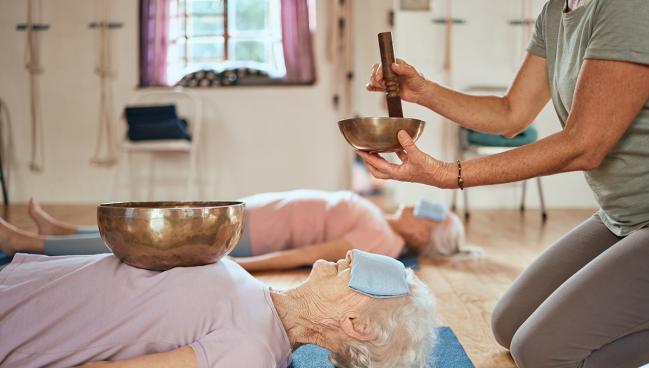Query Use of Nontraditional Therapies for HF at Every Visit: AHA Statement
Some complementary and alternative therapies have potential benefits, but others may be harmful, the authors caution.

A new scientific statement from the American Heart Association (AHA) tackles the use of complementary and alternative therapies (CAM) in patients with heart failure, some of which may provide benefits and others harm.
More than 30% of patients with heart failure are estimated to use nontraditional products either on top of or in place of conventional medical therapies, and there is the potential for some of these largely unregulated remedies to interact in dangerous ways with prescribed treatments, according to a writing group chaired by Sheryl Chow, PharmD (Western University of Health Sciences, Pomona, CA).
Many patients don’t tell their doctors they’re taking CAM, a term that “has been traditionally used to define medical practices, products, or systems that do not conform to the standard beliefs of conventional medicine,” the authors note. That includes things ranging from herbal remedies and dietary supplements to practices like tai chi and yoga.
“Moreover, healthcare professionals do not routinely inquire or document alternative therapies and may also lack resources to evaluate these agents,” Chow told TCTMD via email. “This represents a major public health problem given that consumers are frequently purchasing these potentially dangerous and minimally regulated products without the knowledge or advice from a healthcare professional.”
This AHA statement, published Thursday in Circulation, provides a resource for clinicians as they navigate care for their patients with heart failure, with tables and figures that provide an overview of the potential risks and benefits of various nontraditional treatments.
“Cardiologists should strongly encourage all patients to disclose use and frequency of CAM at every clinic visit,” Chow said. “It is also important to engage their team of healthcare professionals, including the pharmacist, to assess safety/interactions and to work with the patient to develop a shared and informed decision-making plan moving forward.”
Potential Benefits and Harms
Chow et al searched the literature for publications related to CAM use in the setting of heart failure (HF) to look for evidence of efficacy and to review safety, including the potential for direct toxic effects and for interactions with standard HF treatments. The document provides two tables and a figure that give an overview of mechanisms of action, major studies, potential benefits and harms, interactions with HF therapies, and information on use in women who are pregnant and/or lactating for various CAM therapies or practices.
Alcohol and caffeine are included in the discussion of nontraditional therapies that patients with heart failure might use to manage their symptoms, as they have potential benefits in certain cases but can be dangerous in others. There is some observational data supporting a lower risk of developing heart failure with low-to-moderate amounts of alcohol, but other studies showing cardiotoxic effects leading to cardiomyopathy and heart failure at higher levels of intake or with habitual use, the authors note. Alcohol may also “potentiate the effect of diuretics or vasodilators.”
When it comes to caffeine, Chow pointed out, there are concerns for use in the setting of heart failure “given the risk of increased BP and diuresis with three to five cups of coffee (500 mg of caffeine) within 5 hours.”
The strongest evidence of benefit among CAM agents in the setting of heart failure, according to the statement, is seen for omega-3 polyunsaturated fatty acids, or fish oil. The GISSI-HF trial, for instance, showed that among patients with chronic heart failure, use of fish oil supplementation on top of standard care provided small reductions in death and CV hospitalization. And in VITAL-HF, a fish oil supplement didn’t reduce the primary endpoint of first HF hospitalizations but did lower the risk of recurrent HF hospitalizations. In the latest US heart failure guidelines, omega-3 polyunsaturated fatty acid supplementation has a class 2b recommendation for reducing mortality and CV hospitalization.
Overall, “the data suggest a modest benefit with adjunctive use of fish oil in patients with HF, but risk of atrial fibrillation appears to be dose-dependent,” Chow said, “Therefore, the benefits and risks need further consideration.”
Tai chi and yoga have some evidence from randomized trials to support positive clinical effects in patients with heart failure when added to standard therapies. These include improvements in quality of life, mood, and exercise self-efficacy and tolerance, in addition to reductions in serum inflammatory markers. “Yoga and tai chi can be used as adjunctive wellness approaches to guideline-directed medical therapy to improve exercise tolerance and quality of life,” the authors conclude.
But other CAM agents, including many herbal supplements, are listed as potentially harmful. Blue cohosh, which has been used for amenorrhea or dysmenorrhea, for example, may dampen the effects of antihypertensive and antidiabetic drugs. Gingko biloba interacts with warfarin to increase INR. And lily of the valley and other herbal remedies containing cardiac glycosides may have toxic effects in the presence of digoxin, leading to nausea, palpitations, and visual disturbances.
“The effects can be potentiated in the setting of hypokalemia, so these agents should not be combined with potassium-wasting drugs, such as loop diuretics and corticosteroids, without careful monitoring of potassium levels,” Chow et al write.
Educating Patients
Chow said that the widespread use of CAM agents by patients with heart failure is “a major public healthcare problem on multiple levels.”
She pointed out that the agents are “largely unregulated” by the US Food and Drug Administration and that manufacturers don’t have to prove efficacy or safety before putting their products on the market. In addition, there’s no regulation of purity, quality, or strength of herbal remedies and supplements, so seemingly similar products on the shelf may contain different concentrations and purity.
“It is important that both healthcare professionals and consumers improve communication about over-the-counter therapies and are educated about potential efficacy and risk of harm so that shared and informed decision-making can occur,” Chow said, adding that consumers can check the website of the USP dietary supplements verification program to vet various products.
Ultimately, the statement authors say, “more research and well-powered randomized controlled trials are warranted to further evaluate CAM efficacy and adverse effects in this population. Education, communication, and collaboration between patients, multidisciplinary healthcare professionals, and nontraditional practitioners are encouraged in patients with HF to promote transparency and improve outcomes.
Todd Neale is the Associate News Editor for TCTMD and a Senior Medical Journalist. He got his start in journalism at …
Read Full BioSources
Chow SL, Bozkurt B, Baker WL, et al. Complementary and alternative medicines in the management of heart failure: a scientific statement from the American Heart Association. Circulation. 2022;Epub ahead of print.
Disclosures
- Chow reports no relevant conflicts of interest.





Comments